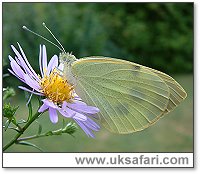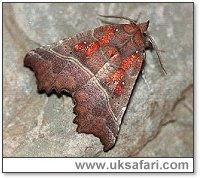
|

|
|
 Sent
to you Sent
to you
by e-mail
|
|
Simply
enter your details and hit the send button
more
info |
|


Click Here

Links
Advertise
Terms of Use
Contributors
About Us
Contact Us
|
 |
Go back
 | Bookmark
| Bookmark
 | Print Page
| Print Page  | E-Mail Us
| E-Mail Us 
How Can You Tell a Moth from a
Butterfly?

Photo: G. Bradley
|
|
UK
Safari Tip:
Need help identifying butterflies? Try this beautifully illustrated fold
out chart - click here
|
|
Butterflies and moths both belong to a group of insects called Lepidoptera. Roughly translated from Greek the word means "wings of scale".
If you look closely with a strong magnifier
at the wings of a moth or butterfly you'll notice that they
are covered in tiny scales. It's these scales which produce the brilliant
colours we see. As light passes through the scales, it is reflected in different
directions, and in many cases, the resulting appearance is a brilliant and iridescent wing.
One way to tell moths and butterflies apart is to watch them when they are resting. Most butterflies rest with their wings held together above their back, while the majority of moths rest with their wings folded flat.

Photo: G. Bradley
Also, if you look at the antennae of most European butterflies you'll notice that they have a bulbous tip. When you look at those of moths
(below) you'll see that they are mostly feathery, and they get thinner at the ends.
A butterfly forms a chrysalis which hangs, while a moth forms a cocoon, usually on the ground,
surrounded by silk.
Most butterflies have a proboscis, which is a bit like a coiled up drinking
straw. This is used for feeding on nectar. Most moths do all their feeding in
the caterpillar stage of life, so have no use for one.

UK Safari Moth Section
UK Safari Butterfly Section
|
 |

|